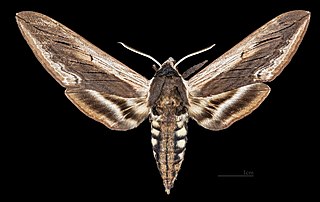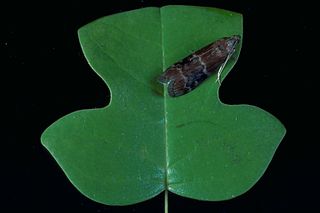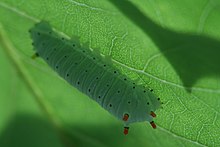
Saturniidae, commonly known as saturniids, is a family of Lepidoptera with an estimated 2,300 described species. The family contains some of the largest species of moths in the world. Notable members include the emperor moths, royal moths, and giant silk moths.

Samia cynthia, the ailanthus silkmoth, is a saturniid moth, used to produce silk fabric but not as domesticated as the silkworm, Bombyx mori. The moth has very large wings of 113–125 mm (4.4–4.9 in), with a quarter-moon shaped spot on both the upper and lower wings, whitish and yellow stripes and brown background. There are eyespots on the outer forewings. The species was first described by Dru Drury in 1773.

Manduca florestan, the Florestan sphinx, is a moth of the family Sphingidae. The species was first described by Caspar Stoll in 1782.

Manduca muscosa, the muscosa sphinx, is a moth of the family Sphingidae.

Manduca occulta, the occult sphinx, is a moth of the family Sphingidae.

Sphinx asellus, the asellus sphinx moth, is a moth of the family Sphingidae. The species was first described by Walter Rothschild and Karl Jordan in 1903. It is known from pinyon-juniper woodland and similar arid areas in the US states of Colorado, Nevada, Utah, extreme south-western Wyoming, Arizona, New Mexico and south-western Texas.

Sphinx dollii, or Doll's sphinx moth, is a moth of the family Sphingidae. It is known from arid brushlands and desert foothills from Nevada and southern California east through Utah, Arizona, Colorado, and from New Mexico to Oklahoma and Texas.

Sphinx drupiferarum, the wild cherry sphinx, is a moth of the family Sphingidae. The species was first described by James Edward Smith in 1797.

Lintneria ermitoides, the sage sphinx, is a moth from the family Sphingidae. The species was first described by Herman Strecker in 1874. It is known from North America's sandy prairies in the Great Plains from Kansas south through central Oklahoma to Texas, and possibly west to Colorado and New Mexico, and as a rare stray to western Missouri.

Sphinx franckii, or Franck's sphinx moth is a moth in the family Sphingidae. The species was first described by Berthold Neumoegen in 1893. It is known from lowland deciduous woodland in the eastern United States but also suburban areas where lilacs are planted, ranging from New York to northern Florida east to Missouri and Louisiana.

Erinnyis alope, the Alope sphinx, is a moth of the family Sphingidae. It lives from the northern part of South America, through Central America, up to Northern Mexico and the very south of the United States, although strays have been recorded as far north as Arkansas and Kansas.

Perigonia lusca, the half-blind sphinx or coffee sphinx, is a moth of the family Sphingidae. It was first described by Johan Christian Fabricius in 1777.

Aellopos clavipes, also known as the clavipes sphinx, is a moth of the family Sphingidae.

Aellopos titan, the Titan sphinx, is a moth of the family Sphingidae. The species was first described by Pieter Cramer in 1777.

Eumorpha vitis, known as the vine sphinx, is a moth of the family Sphingidae.

The Saturniinae or saturniines are a subfamily of the family Saturniidae. They are commonly known as emperor moths or wild silk moths. They are easily spotted by the eyespots on the upper surface of their wings. Some exhibit realistic eye-like markings, whilst others have adapted the eyespots to form crescent moon or angular shapes or have lost their wing scales to create transparent windows. They are medium to very large moths, with adult wingspans ranging from 7.5 to 15 cm, in some cases even more. They consist of some of the largest groups of Lepidoptera like the moon or luna moth, atlas moth, and many more. The Saturniinae is an important source of wild silk and human food in many different cultures.

Callosamia promethea, commonly known as the promethea silkmoth, is a member of the family Saturniidae, which contains approximately 1,300 species. It is also known as the spicebush silkmoth, which refers to is one of the promethea silkmoth's common host plants, spicebush. C. promethea is classified as a silk moth, which stems from its ability to produce silk, which it does in the formation of its cocoon. C. promethea lives in forests in the eastern U.S. and does not damage the trees on which it lives. The species was first described by Dru Drury in 1773.

Pachylioides is a monotypic moth genus in the family Sphingidae erected by Ronald W. Hodges in 1971. Its only species, Pachylioides resumens, was first described by Francis Walker in 1856.

Hyalophora columbia, the Columbia silkmoth or larch silkmoth, is a moth of the family Saturniidae. In the east it is found from Quebec and Ontario to Michigan, northern Wisconsin, and south-eastern Manitoba. In the west it is found from Alberta and Montana south through the Rocky Mountains to south-western Texas and into central Mexico. The species was first described by Sidney Irving Smith in 1865.

Euzophera ostricolorella, the root collar borer moth or tuliptree borer, is a species of moth of the family Pyralidae. It was described by George Duryea Hulst in 1890. The species is found in the United States from Arkansas and Louisiana to northern Florida, north to Michigan and New York.




















